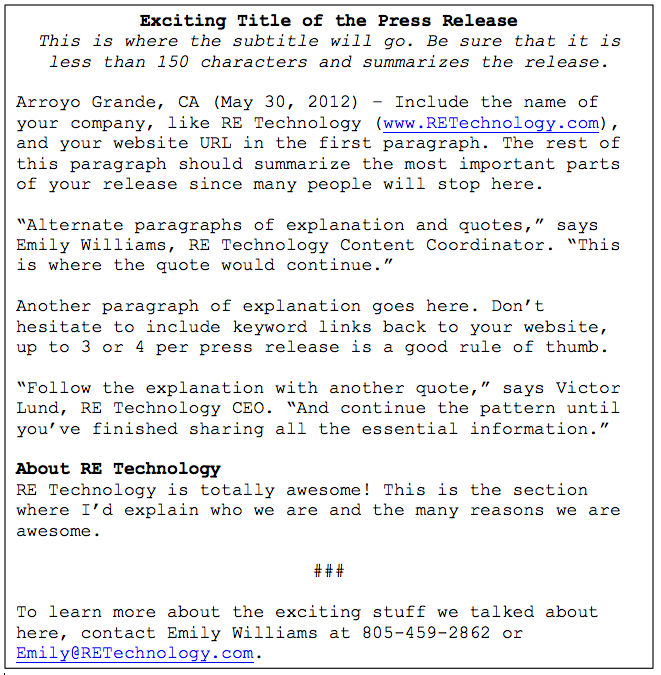You are viewing our site as an Agent, Switch Your View:
Agent | Broker Reset Filters to Default Back to ListHow to Write a Press Release
May 30 2012
Several months ago, I wrote an article that detailed the many reasons you should write press releases. However, I recently realized that I #failed in one important way – I left out how to write press releases. Today, I’m going to remedy that situation!
Example
Are you a visual learner? Here’s an example to help you picture all of this. Keep in mind that I’ll be talking about each of the components in more detail below.

Components
So, let’s break down a press release into its component parts.
1) Title/Headline
You’ll want to create a short, catchy title for your press release. While it should grab the reader’s attention, the meaning and subject matter of the release should still be 100% clear by reading it.
Some sources will tell you that the title of your press release should be in all capital letters; DON’T BELIEVE THEM. It’s perfectly acceptable - and in my personal opinion, preferable - to use standard title case (explained relatively well here).
2) Subtitle
Your subtitle will appear directly below the title of your release. It should be a very short summary of what the release will cover. How short is very short? I try to keep my subtitles below 150 characters.
Your subtitle may feel a little redundant to you. I can’t tell you how many times we receive press releases to publish on RET that don’t include subtitles. But this leaves those of us doing the publishing in the uncomfortable position of making up a subtitle to fill that space – and, to be safe, we end up with “News from [name of company here].” Now, I think you’ll agree, that’s far from an effective use of space and the company would be much better served by crafting a compelling subtitle that draws in the reader (think something along the lines of “Totally awesome company does this really exciting thing that will benefit you in X, Y, and Z big way!”).
3) Location and Date
Where and when is this press release being published?
I usually use this format: May 30, 2012 (Arroyo Grande, CA).
You don’t have to use the location where YOU are personally drafting the release; there may be another place where you have a presence that you’d prefer citing – for instance, many companies choose to use the location of their corporate headquarters.
4) Body of the Press Release
The first paragraph of your press release is arguably the most important part. Frankly, many people will read the first paragraph and stop there; it’s sad, but true, so important to keep in mind. In the first paragraph (probably the first sentence of the first paragraph), you’ll want to include a mention of your company. Immediately following this mention, you’ll want to include your website URL in parentheses.
For the remainder of the press release body, I like to follow an explanation-quote-explanation-quote pattern. This means that I’ll alternate a paragraph of explanation (like my first paragraph) with a paragraph made up of a quote. I repeat this pattern until I’ve covered all my key points. When you’re quoting someone, be sure to include their full name and title with the company.
Here are a few other tips for the body of the release:
- Include images. Charts, graphs, and other informational images are very helpful.
- Break up your text. Include subheadings, bulleted lists, numbered lists, and shorter paragraphs. Don’t just fall back on long, rambling paragraphs.
5) “About Us” Section
The last paragraph (before the “###” marking the end of the release, which we’ll talk about next) should be an “About Us” section. It’s a few sentences that provides a brief summary of who you are and what you do.
6) Conclusion
To indicate the end of the official press release, type: ###. Below the ###, you should include contact information for your company. This information probably will not get published on the Web but will be available to whomever receives the release.
Disclaimer
There may be a handful of “rules” for writing press releases, but much of what I’ve included here are simply recommendations based on my own approach. If you’re an experienced press release writer, there’s no need for you to reinvent the wheel – just keep doing what you’ve been doing if it’s working for you. We’d love for you to add your tips and tricks! And, if you disagree with any of my points, feel free to correct me; this is just my technique, but it is not the only technique.
Still feeling overwhelmed? We offer content creation services to help busy real estate companies. Email Melissa McHone ([email protected]) to learn more about our press release writing services.









